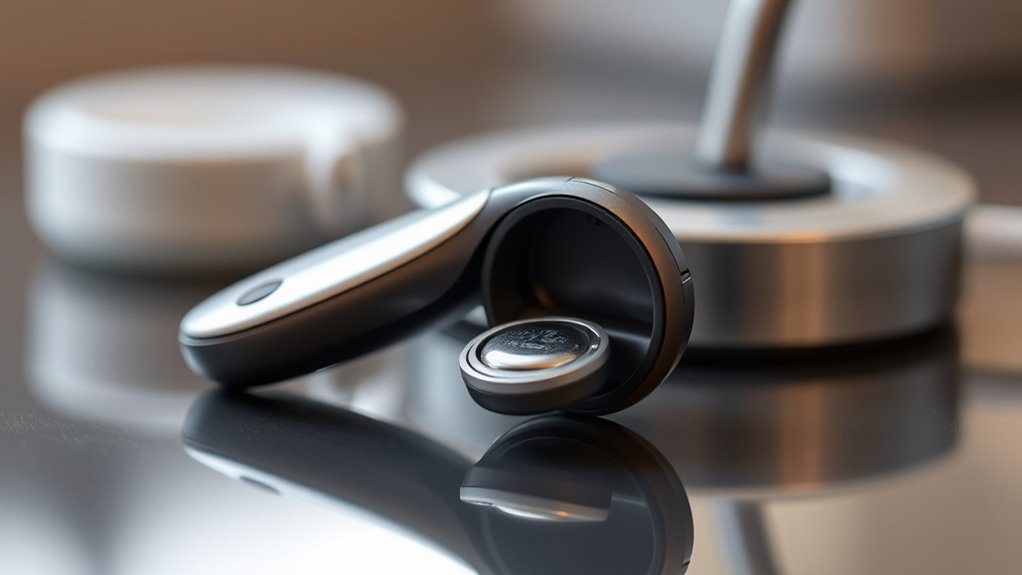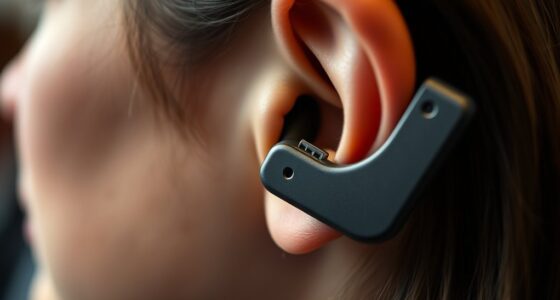Rechargeable batteries in hearing devices offer many advantages, like convenience, eco-friendliness, and long-term savings, since you don’t need to buy disposable batteries often. They support easy overnight charging and reduce waste, helping the environment. However, they can degrade over time, may not be compatible with all devices, and require proper maintenance. If you want to discover how to maximize their benefits and tackle potential challenges, there’s more to contemplate.
Key Takeaways
- Rechargeable hearing batteries offer consistent performance, convenience, and reduce the need for frequent disposable battery replacements.
- They support sustainable practices, lowering environmental impact and promoting recycling efforts.
- Battery degradation over time may require replacements, and charging stations might not always be accessible.
- Limited battery lifespan and potential compatibility issues can impact long-term reliability and user convenience.
- Proper maintenance and planning are essential to ensure continuous device use and maximize battery longevity.
Advantages of Using Rechargeable Batteries in Hearing Devices
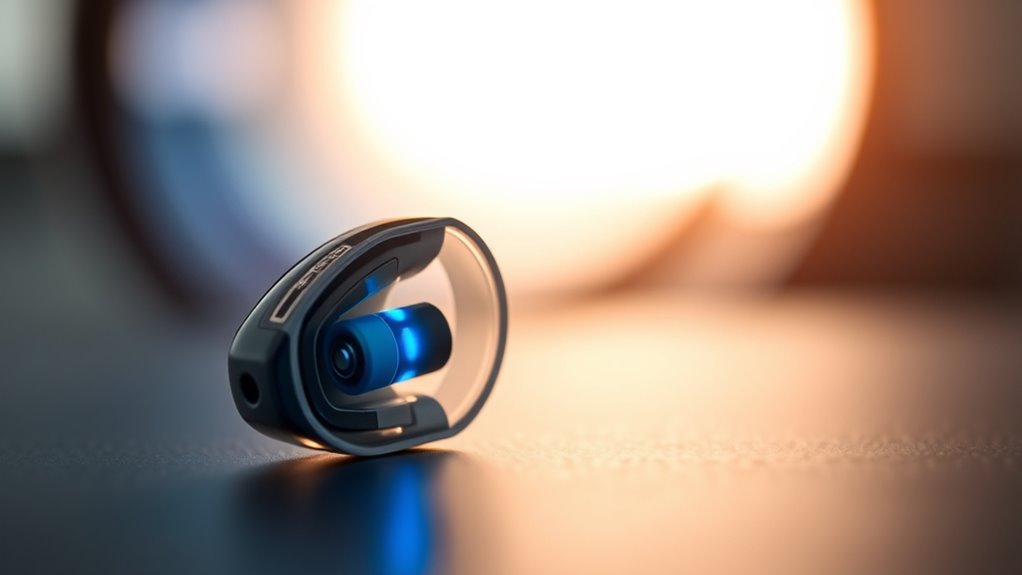
Rechargeable batteries offer several key advantages for hearing devices. Improved battery technology means you no longer need to swap out tiny disposable batteries, which can be inconvenient and costly over time. Instead, you get consistent performance with each charge, reducing interruptions in your hearing experience. This enhances user convenience, as you can simply recharge your device overnight or during routine charging times. Modern rechargeable batteries are designed to last through the day, eliminating worries about running out of power when you need it most. Plus, fewer battery replacements mean less maintenance and mess, making your hearing device easier to care for. Additionally, Vetted information on data collection and user privacy emphasizes the importance of secure and transparent handling of personal information, which is increasingly relevant in connected hearing devices. Overall, advancements in battery technology make rechargeable hearing aids a more reliable, user-friendly choice for everyday use.
Environmental Benefits of Rechargeable Hearing Aids
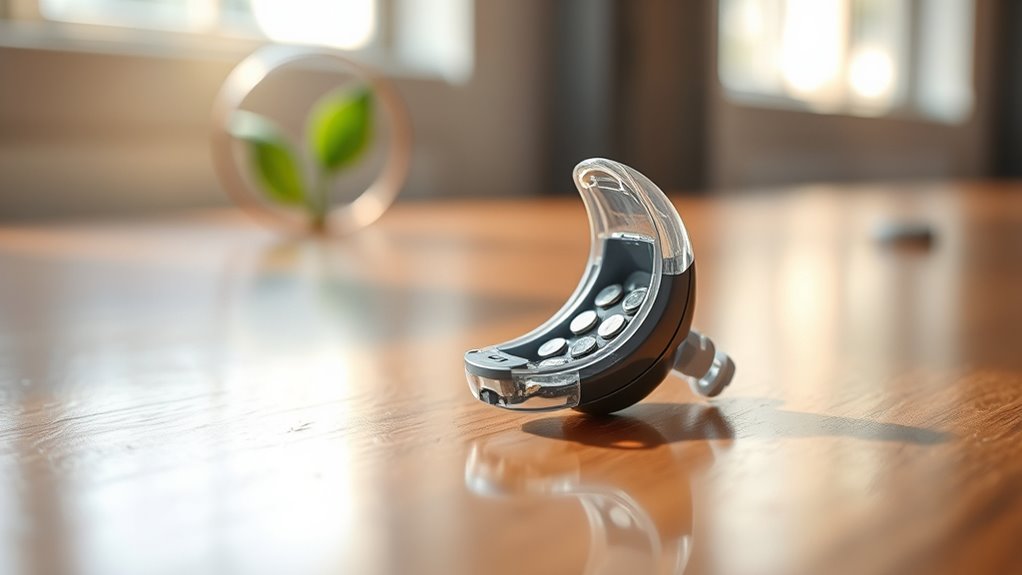
Because they reduce the need for disposable batteries, rechargeable hearing aids considerably benefit the environment. By using rechargeable batteries, you decrease landfill waste and lessen the demand for single-use batteries, which often contain harmful chemicals. Many manufacturers support recycling programs to ensure batteries are disposed of safely, preventing environmental contamination. Additionally, some hearing aids are made with eco friendly materials, further reducing their ecological footprint. These sustainable choices help conserve natural resources and promote responsible manufacturing practices. Switching to rechargeable devices not only saves you money over time but also contributes to a cleaner planet. Embracing these environmentally conscious options makes your hearing aid use more sustainable and aligns with broader efforts to protect our environment. Furthermore, adopting creative problem-solving approaches in designing and recycling batteries can lead to innovative solutions that minimize ecological impact.
Common Challenges and Limitations

Rechargeable hearing devices face several challenges that might affect your experience. The batteries don’t last forever and need replacement or recharging, which can be inconvenient. Additionally, charging stations may not be accessible everywhere, and some devices might not be compatible with certain batteries or chargers. Proper maintenance and occasional replacement are essential to ensure optimal performance, similar to the importance of battery longevity in rechargeable systems.
Limited Battery Lifespan
While rechargeable batteries offer many benefits for hearing devices, their limited lifespan remains a significant challenge. Over time, battery degradation reduces their ability to hold a charge, meaning you’ll notice shorter usage between charges. This decline typically leads to increased replacement frequency, which can become inconvenient and costly. As the batteries age, their capacity diminishes, requiring more frequent replacements to maintain ideal device performance. You might find yourself replacing batteries sooner than expected, disrupting your daily routine. Although advancements have improved battery longevity, no rechargeable battery lasts forever. Understanding this limitation helps you plan for eventual replacements and manage expectations. Additionally, battery degradation is influenced by factors like usage patterns and environmental conditions, which can further impact lifespan. Ultimately, while rechargeable options are convenient, their finite lifespan is an ongoing challenge that affects both users and manufacturers alike.
Charging Accessibility Issues
Charging accessibility can pose significant challenges for hearing device users, especially in situations where convenient power sources aren’t readily available. Accessibility barriers may prevent you from easily finding charging stations or outlets when needed. Here are some common issues:
- Limited availability of charging stations in public spaces can leave you stranded without power.
- Inconvenient or incompatible charging ports may make it difficult to recharge your device.
- Power outages or lack of accessible outlets at home can disrupt your daily routine.
- Understanding home technology compatibility can help you better plan for reliable charging options.
These challenges mean you might need to plan ahead or carry portable chargers. Overcoming accessibility barriers requires awareness of your environment and reliable charging options to keep your hearing device powered and functioning smoothly.
Potential Device Compatibility
Have you ever encountered compatibility issues when trying to recharge your hearing device? Device size can be a limiting factor, as not all rechargeable batteries fit every hearing aid model. Some devices are designed for specific battery sizes, so switching to a different rechargeable type might not be possible without hardware adjustments. Battery type compatibility is also a concern; not all rechargeable batteries are compatible with existing hearing aid electronics. Using an incompatible battery can cause malfunction or damage. Before switching to rechargeable options, check your device’s specifications to ensure the battery size and type match. Compatibility issues can lead to increased costs and inconvenience, making it essential to verify your hearing device’s requirements before adopting rechargeable batteries.
Cost Considerations and Long-term Savings

Switching to rechargeable batteries requires an initial investment, but it can save you money over time. You’ll also reduce ongoing expenses from replacing disposable batteries regularly. Considering these costs helps you see the long-term financial benefits of choosing rechargeable options. Additionally, lifestyle changes such as incorporating regular maintenance routines can extend the lifespan of your hearing devices and further enhance cost savings.
Upfront Investment Costs
Although rechargeable batteries often cost more upfront than traditional disposable options, they can lead to significant savings over time. Your initial cost includes not only the price of the rechargeable battery but also ensuring your device is compatible with this technology. Here are key points to weigh:
- Initial Cost: Rechargeable hearing devices tend to have a higher upfront price, primarily due to advanced battery technology.
- Device Compatibility: Confirm your hearing aid supports rechargeable batteries; not all models do, affecting your investment.
- Long-term Savings: Despite higher initial costs, you’ll save money over time by avoiding repeated purchases of disposable batteries.
- Methodologies and Objectives: Understanding the methodologies used in battery testing can help ensure you select a reliable and long-lasting rechargeable option.
Balancing initial investment against long-term benefits can help you decide if rechargeable batteries are the right choice for your hearing needs.
Ongoing Replacement Expenses
While rechargeable batteries may require periodic replacement or maintenance, they typically incur lower ongoing costs compared to constantly buying disposable batteries. Over time, you save money by avoiding frequent purchases and reducing battery waste. Proper battery disposal is essential to minimize environmental impact, and many manufacturers include recycling programs. Warranty coverage can also protect you from unexpected expenses if your rechargeable battery fails prematurely. Keep in mind that some batteries might need replacement after a few years, but overall, the costs are predictable and manageable. Additionally, understanding battery lifespan can help you plan for future replacements more effectively. Here’s a quick comparison:
| Expense Type | Disposable Batteries | Rechargeable Batteries | Notes |
|---|---|---|---|
| Replacement Cost | Frequent, ongoing | Less frequent, longer lifespan | Lower long-term expenses |
| Battery Disposal | Regular disposal needed | Recycle programs available | Environmentally friendly |
| Warranty Coverage | Usually limited or none | Often included, covers defects | Protects your investment |
Long-term Financial Benefits
Investing in rechargeable batteries for your hearing devices can lead to significant long-term savings. Over time, you’ll spend less on disposable batteries and reduce waste through battery recycling, making your choice more eco-friendly. Consider these benefits:
- Lower ongoing costs—rechargeables last hundreds of cycles, saving you money.
- Increased user convenience—no more frequent battery swaps, just quick recharging.
- Environmental impact—recyclable batteries help minimize landfill waste and promote sustainability.
- Additionally, choosing rechargeable batteries aligns with expert advice on responsible pet ownership and environmental stewardship, emphasizing long-term benefits over short-term convenience.
Maintenance and Care for Rechargeable Batteries
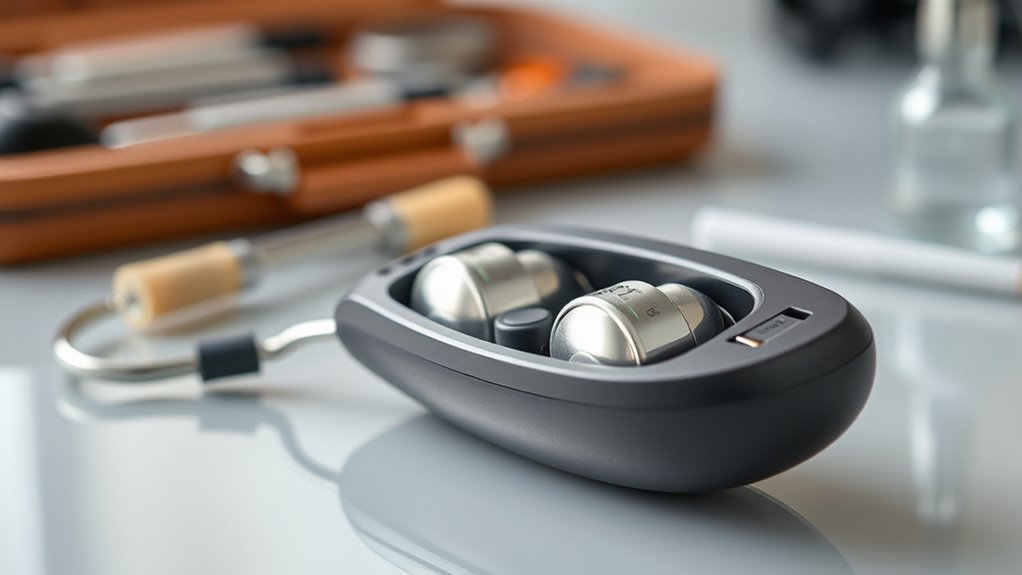
Proper maintenance and care are essential to guarantee your rechargeable hearing device batteries perform at their best and last longer. To do this, focus on proper battery storage; keep your devices in a cool, dry place, away from extreme temperatures, to prevent capacity loss. Follow regular cleaning routines by gently wiping the battery contacts and charging ports with a soft, dry cloth. Avoid exposing batteries to moisture or dirt, which can interfere with charging and performance. Make sure to fully discharge and recharge batteries as recommended by the manufacturer to maintain peak function. Additionally, avoid leaving your hearing devices unused for extended periods without charging, as this can diminish battery life. Consistent care ensures your batteries stay reliable, extending their lifespan and supporting your hearing health. Monitoring AI vulnerabilities highlights the importance of ongoing vigilance to ensure safety and optimal performance.
Making the Right Choice for Your Hearing Needs
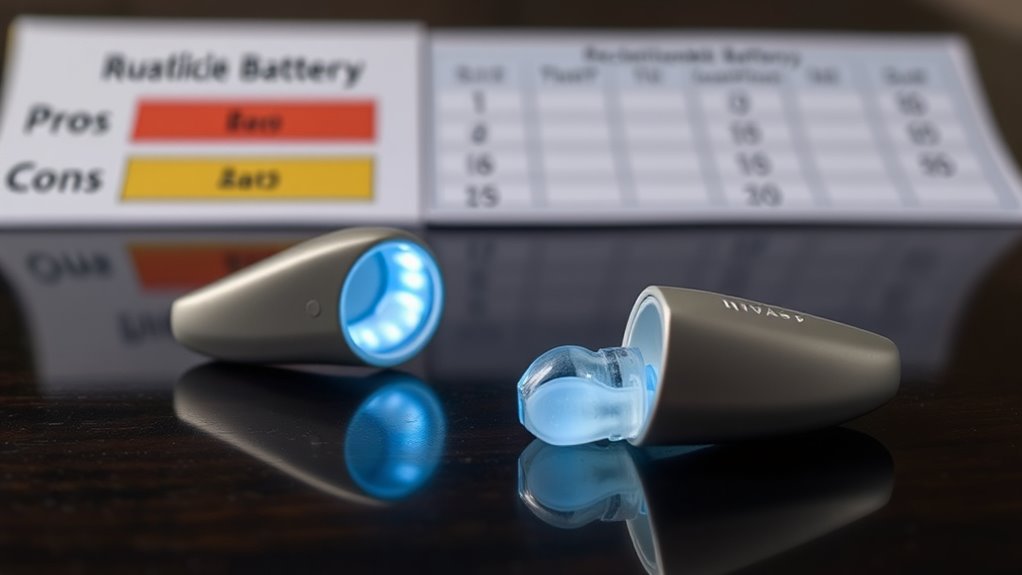
Choosing the right rechargeable hearing device depends on understanding your specific hearing needs and lifestyle. To make an informed decision, consider these key factors:
- Daily Usage: If you’re active and on the go, opt for a device with portable charging options to avoid frequent battery replacements.
- Environmental Impact: Think about battery recycling options. Some devices make it easier to recycle batteries safely, reducing environmental harm.
- Battery Longevity: Evaluate how long the batteries last per charge and how easy they are to replace or recharge, ensuring they meet your daily demands.
Matching these factors to your routine will help you select a hearing device that’s convenient, eco-friendly, and reliable for your needs.
Frequently Asked Questions
How Long Do Rechargeable Hearing Aid Batteries Typically Last per Charge?
You might wonder how long rechargeable hearing aid batteries last per charge. Typically, their battery lifespan ranges from 16 to 24 hours of use, depending on your device and usage. You’ll need to charge them daily or every couple of days, based on your hearing aid’s power consumption. Regular charging reduces the need for battery replacements and guarantees consistent performance, so keeping track of your charging frequency helps maintain ideal hearing aid function.
Are There Specific Brands That Offer the Best Rechargeable Hearing Aids?
Think of choosing a rechargeable hearing aid as picking a trusted compass for your journey. Brands like Phonak, Oticon, and ReSound shine brightly with stellar reputation and innovative battery technology. They offer reliable performance, quick charging, and long-lasting power. Your best bet is to research each brand’s reputation and battery features, ensuring you pick a device that feels like a dependable partner, guiding you comfortably through your day.
Can Rechargeable Batteries Be Replaced in Existing Hearing Devices?
You might wonder if you can replace rechargeable batteries in your hearing device. Usually, rechargeable batteries are built-in and aren’t replaceable like traditional batteries. Check your device’s compatibility; some models have sealed designs, making battery replacement impossible. If your device allows battery replacement, follow manufacturer instructions carefully. Otherwise, you may need to upgrade to a new hearing aid with a removable battery or consider professional servicing.
What Safety Precautions Should I Take With Rechargeable Hearing Aid Batteries?
Think of handling rechargeable hearing aid batteries like tending a delicate garden. You should always handle batteries carefully, avoiding touching the terminals to prevent short circuits. Keep batteries away from metal objects, and never force them into place. Follow proper charging safety by using the recommended charger, avoiding overcharging, and charging in a dry, cool area. Always store batteries out of reach of children and pets for safety.
Do Rechargeable Hearing Aids Work Well During Long Outdoor Activities?
During long outdoor activities, rechargeable hearing aids often perform well, thanks to their good outdoor durability and battery longevity. You’ll appreciate how they maintain power through extended use, especially if you choose models with larger batteries or quick recharge features. Just remember to keep them charged beforehand and carry a portable charger if needed. This way, your hearing devices stay reliable, ensuring clear hearing no matter how long you’re outdoors.
Conclusion
Choosing rechargeable batteries for your hearing device offers many benefits, but it also comes with challenges. Will you find the perfect balance between convenience and reliability? As you weigh the environmental impact and long-term savings, the decision becomes clearer. Stay tuned—your ideal hearing solution might be closer than you think. Don’t rush, though; consider all factors carefully, because the right choice could transform your daily life in ways you never imagined.

